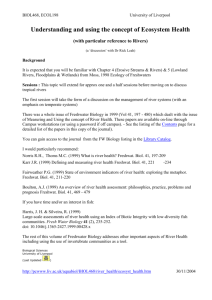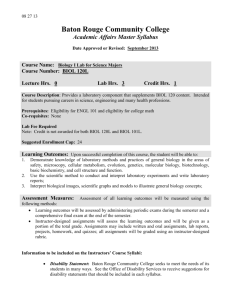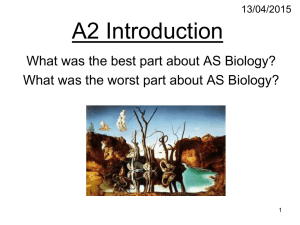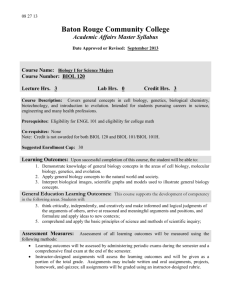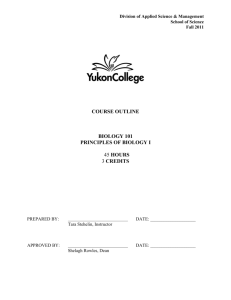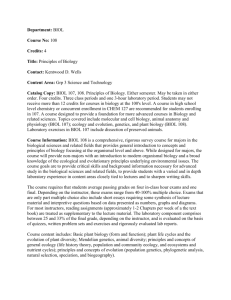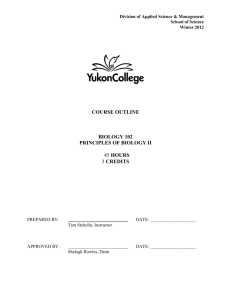BIOL 101 - Tompkins Cortland Community College
advertisement
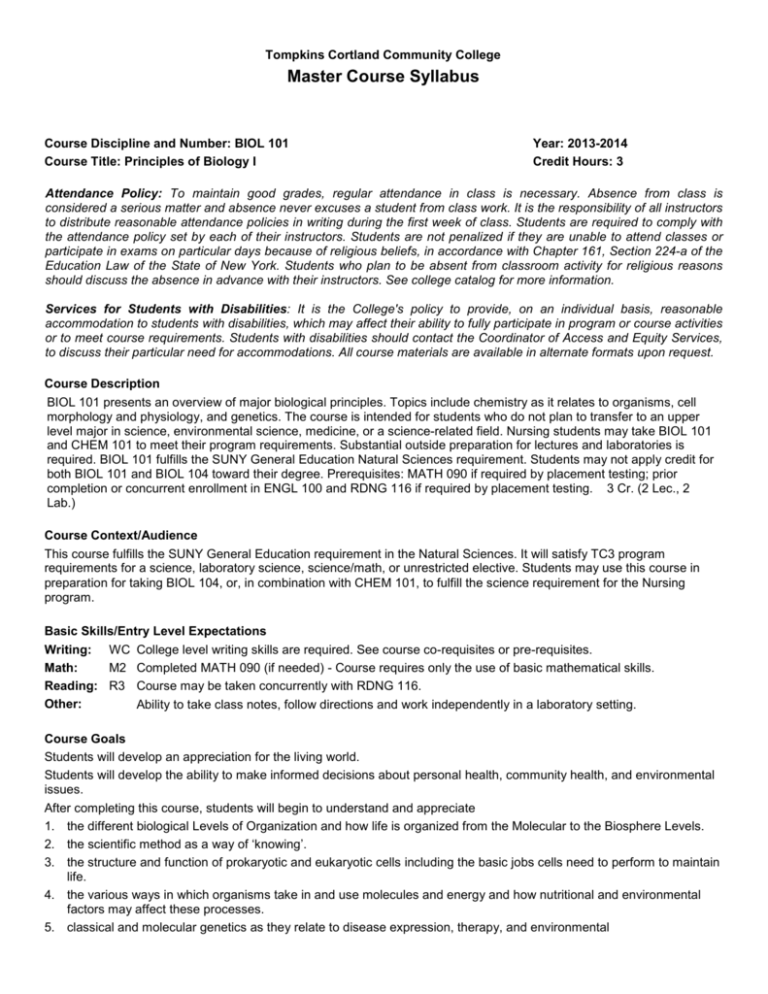
Tompkins Cortland Community College Master Course Syllabus Course Discipline and Number: BIOL 101 Course Title: Principles of Biology I Year: 2013-2014 Credit Hours: 3 Attendance Policy: To maintain good grades, regular attendance in class is necessary. Absence from class is considered a serious matter and absence never excuses a student from class work. It is the responsibility of all instructors to distribute reasonable attendance policies in writing during the first week of class. Students are required to comply with the attendance policy set by each of their instructors. Students are not penalized if they are unable to attend classes or participate in exams on particular days because of religious beliefs, in accordance with Chapter 161, Section 224-a of the Education Law of the State of New York. Students who plan to be absent from classroom activity for religious reasons should discuss the absence in advance with their instructors. See college catalog for more information. Services for Students with Disabilities: It is the College's policy to provide, on an individual basis, reasonable accommodation to students with disabilities, which may affect their ability to fully participate in program or course activities or to meet course requirements. Students with disabilities should contact the Coordinator of Access and Equity Services, to discuss their particular need for accommodations. All course materials are available in alternate formats upon request. Course Description BIOL 101 presents an overview of major biological principles. Topics include chemistry as it relates to organisms, cell morphology and physiology, and genetics. The course is intended for students who do not plan to transfer to an upper level major in science, environmental science, medicine, or a science-related field. Nursing students may take BIOL 101 and CHEM 101 to meet their program requirements. Substantial outside preparation for lectures and laboratories is required. BIOL 101 fulfills the SUNY General Education Natural Sciences requirement. Students may not apply credit for both BIOL 101 and BIOL 104 toward their degree. Prerequisites: MATH 090 if required by placement testing; prior completion or concurrent enrollment in ENGL 100 and RDNG 116 if required by placement testing. 3 Cr. (2 Lec., 2 Lab.) Course Context/Audience This course fulfills the SUNY General Education requirement in the Natural Sciences. It will satisfy TC3 program requirements for a science, laboratory science, science/math, or unrestricted elective. Students may use this course in preparation for taking BIOL 104, or, in combination with CHEM 101, to fulfill the science requirement for the Nursing program. Basic Skills/Entry Level Expectations Writing: WC College level writing skills are required. See course co-requisites or pre-requisites. Math: M2 Completed MATH 090 (if needed) - Course requires only the use of basic mathematical skills. Reading: R3 Course may be taken concurrently with RDNG 116. Other: Ability to take class notes, follow directions and work independently in a laboratory setting. Course Goals Students will develop an appreciation for the living world. Students will develop the ability to make informed decisions about personal health, community health, and environmental issues. After completing this course, students will begin to understand and appreciate 1. the different biological Levels of Organization and how life is organized from the Molecular to the Biosphere Levels. 2. the scientific method as a way of ‘knowing’. 3. the structure and function of prokaryotic and eukaryotic cells including the basic jobs cells need to perform to maintain life. 4. the various ways in which organisms take in and use molecules and energy and how nutritional and environmental factors may affect these processes. 5. classical and molecular genetics as they relate to disease expression, therapy, and environmental Course Outcome/Topics # Outcome/Topic # Hours 1 The student will be able to describe the properties of life, and list the Levels of Organization around which this course is built, and to state an example of each. 1 Hour 2 The student will be able to interpret simple chemical equations and formulae using information from the Periodic Table. 6 Hours 3 The student will be able to list the major types of molecules associated with organisms, describe their structure, state their function, and describe their nutritional/biosynthetic importance. 6 Hours 4 The student will be able to differentiate prokaryotic from eukaryotic cells in terms of structure and function. 6 Hours 5 The student will be able to explain the significance of cellular respiration and biosynthesis and briefly explain how these processes works in the context of cells and ecosystems. 6 Hours 6 The student will be able to explain the significance of photosynthesis, and briefly explain how this process works in the context of cells and ecosystems. 7 The student will be able to explain how cells are able to exchange materials between themselves and their environment. 6 Hours 8 The student will be able to describe the different types of cell division and the function of each type. 8 Hours 9 The student will be able to explain how traits (including diseases) are inherited, according to simple Mendelian, as well as non-Mendelian, patterns of inheritance 8 Hours 10 The student will be able to describe the structure and function of DNA and RNA in terms of the cell cycle and protein synthesis 7 Hours 6 hours General Education Goals - Critical Thinking & Social/Global Awareness CRITICAL THINKING OUTCOMES Students will be able to HOW DOES THE COURSE ADDRESS THE OUTCOMES (Include required or recommended instructional resources, strategies, learning activities, assignments, etc., that must or could be used to address the goal/outcomes) Students will be taught to think scientifically by asking questions and troubleshooting their answers by applying the scientific method to relevant issues. Inquiry-based laboratories such as the Spit Lab and the Butcher, Baker, Candelstick Maker (see lab manual for details). develop meaningful questions to address problems or issues. gather, interpret, and evaluate relevant sources of information. Students will be encouraged to evaluate different sources of biological information from the popular press and the scientific literature. Written paper on current topic in biology e.g. stem cell research, global warming reach informed conclusions and solutions. Students will learn to recognize valid information vs. skewed. Bibliography with 10 citations, 8 reliable 2 skewed. Explain why they think the 2 are skewed. consider analytically the viewpoints of self and others. Students will examine biological topics of controversy. In class debate r.e. current debate in biology. Possible topics: stem cell research, cloning, global warming, hormone like pollution. HOW DOES THE COURSE ADDRESS THE OUTCOMES (Include required or recommended instructional resources, strategies, learning activities, assignments, etc., that must or could be used to address the goal/outcomes) SOCIAL/GLOBAL AWARENESS OUTCOMES Students will begin to understand how their lives are shaped by the complex world in which they live. Students will understand that their actions have social, economic and environmental consequences. Students will examine biological cause-effect relationships in the context of personal choices and social constructs. Describe health aspects of biology, especially cancer, and the types of conditions which result in disease propagation. Group activity present data from epidemiologic studies to class Students will learn to consider biological topics from the standpoint of citizen responsibility (e.g., issues they may encounter at the polls, etc.). Debate/discuss, video – an inconvenient truth. Other topics: pollution, global warming, climate instability and political instability Students will examine the economic costs of acting on or not acting issues they may encounter as voters that pertain to biological science. Global warming and its disproportionate affect on poor, HIV and poverty, disposable goods and landfill space, health care costs. Students will learn how environmental pollutants impact basic cellular processes including transport, respiration, and mitosis/meiosis. Students will also learn about climate change in the context of photosynthesis as a carbon sink. Attend an instructor-selected lecture at Cornell on one of these topics. Write paragraph of experience. Instructional Methods Each section of this course should include 2 hours of lecture and 2 hours of laboratory each week. Discussions should be included as time allows and as appropriate. Methods of Assessment/Evaluation Method % Course Grade Hourly exams covering several chapters; the last exam should incorporate questions about all core concepts 40%-60% Written laboratory reports 20%-40% Short quizzes covering no more than two chapters 10%-20% Participation in class discussions (optional) 0%-10% Text(s) Biology: Concepts and Connections or similar, Campbell, Mitchell Reece, Latest Edition, Benjamin Cummings. Laboratory Activities for Biology 101 or similar, Morris, Latest Edition, Tompkins Cortland Community College. Bibliography Biology. Campbell and Reece, Latest Edition, Benjamin Cummings. Other Learning Resources Audiovisual The Inner Life of the Cell (online) Cycles of Life (DVD) Media QH307.2 .C93 1996 - Reserve - Media - Media Reserve Collection Electronic Instructors are encouraged to use the Angel online learning system. Other No resources specified


